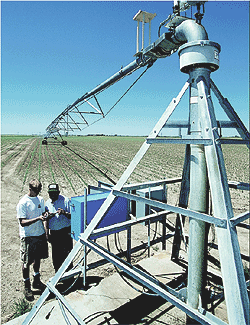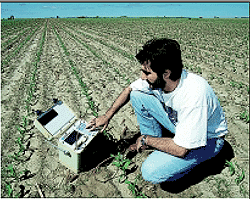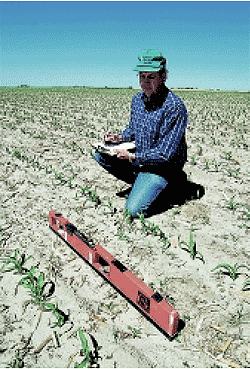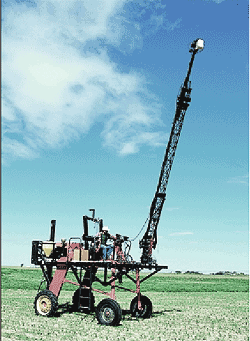|
||||||||
Article | |
| New Systems Research Targets Precision Agriculture's Effectiveness | |
|
| |
| Every farmer knows
that some parts of a field yield better than others. Variable-rate
applicators offer the opportunity to provide just the right amount
of water, nutrients, or pesticides to every part of the field.
Heermann and a group of about 20 other researchers are midway through a 5-year study aimed at helping farmers decide whether variable-rate applicators and other precision farming techniques can improve their crop yields. The uniqueness of the project lies not just in the topic but in the approach: looking at the entire field as a system. Researchers are measuring more than 25 variables across the field. "In most of my projects during the last 30 years, we've set up little plots and varied the component we were interested in, such as nitrogen or water, without paying much attention to how the other factors varied," says ARS agricultural engineer Harold R. Duke. | |
| Duke's experience
has been the reigning experimental paradigm: Assume most variables
are constant, perform experiments on small plots, and extrapolate
results to a larger area without taking into account the myriad
environmental factors present on the farm.
This precision farming project instead tries to look at all possible variables that could affect yield—to determine which are most significant. They also measure how precision agriculture affects the amounts of farming inputs needed—such as water, nutrients, and pesticides—and whether the environment benefits from this intensive management. The goal is to help farmers optimally manage all parts of the field.
Robert Geisick and Larry Rothe—commercial farmers near Wiggins, Colorado—allow scientists to work on more than 300 acres of their cropland for the study. They've seen variability in corn yields of up to 50 bushels per acre across a single irrigated field. Both have been keenly interested in precision farming, and Rothe was independently trying to increase yields by using site-specific fertilizer management. He joined the project after meeting Heermann for lunch. "We assumed fertility was our biggest problem, but we didn't know for sure," Rothe says. "Here was someone who wanted to find out. It didn't take me 10 seconds to agree." Right now, both farms are growing corn under center-pivot irrigation. Sugar beets or onions will enter the rotation in coming years. The multidisciplinary team is looking at water distribution, nitrogen management, nutrient availability, weeds, insects, diseases, herbicide application, and a variety of soil characteristics like organic matter and texture to assess their relative impacts on yield. The first 2 years of the study, which started in 1997, focused on collecting baseline information based on the farmers' standard methods of operation. But even preliminary results are already paying off.
One of the handicaps of precision agriculture to date has been the expense of collecting enough information across a field to apply inputs on a site-specific basis. This study is evaluating several methods that promise to reduce the cost. For example, ARS agricultural engineer Walter C. Bausch uses remote sensing rather than expensive lab analyses to assess where there is adequate nitrogen. "The corn crop appears very healthy, in part because more nitrogen is applied than the crop requires," says Bausch. "That may result in nitrogen leaching." Preliminary results from one area showed that nitrogen fertilizer could be reduced by 35 pounds per acre without reducing grain yield. Preliminary results also show that electrical conductivity of the soil correlates well with yield, but scientists believe this is really a surrogate measurement for other soil factors. | |
| "Electrical
conductivity is related to several soil properties," says Gerald W.
Buchleiter, also an ARS agricultural engineer at Fort Collins. "Its
advantage is that it is easy to measure on the go in the field. You
can measure an entire field in several hours, compared to much
longer times and greater expense for soil coring and laboratory
analysis of samples taken at many points across a field," he says.
Now the team's task is to identify the relationship between the conductivity measurements and factors that affect availability of water and nutrients.
"Making maps for variable-rate application can be expensive and time-consuming," says ARS weed ecologist Lori J. Wiles. "With this project, I can look for correlations between the weed population and other data collected that may lead to faster and less expensive ways to make weed maps." For example, some soil characteristics may provide a good indicator for problem weed locations. The team is working with Valmont Industries of Valley, Nebraska, to develop irrigation-based methods of delivering fertilizer and herbicides at low levels, as well as improving the uniformity of water distribution through center pivots. Together, the researchers hope to create some form of decision support system that helps farmers decide whether precision agriculture would be economically feasible and environmentally beneficial. Researchers suspect it may prove more useful for high-value crops like onions, sugar beets, or potatoes than for corn. Whether or not precision farming is profitable for corn growers, the systems research is likely here to stay. A 1996 study by the National Research Council emphasized the need for agricultural researchers to shift away from discipline-based studies to a systems approach. This team has shown that such an approach can be effective. "I think everyone has been surprised at how smoothly it's gone," says ARS' Duke. "Many scientists of different disciplines are working together very well to find answers." | |
| Adapted from Agricultural Research Magazine: New Systems Research Targets Precision Agriculture's Effectiveness: Vol. 48, No. 10, October 2000, USDA/ARS, by Kathryn Barry Stelljes. | |
| back
to top |




